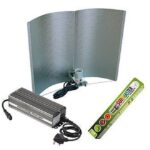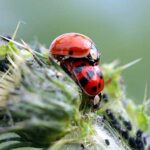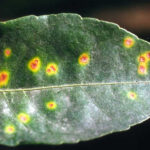The moniker potato bug refers to several insects. The Jerusalem cricket is one such insect, which has a striking appearance and a nasty bite. There are also pill bugs, and three-lined potato bugs. However, today, we’re discussing the Colorado potato beetle (Leptinotarsa decemlineata).
Just like the Jerusalem cricket, these bugs feast upon potatoes. The Jerusalem cricket prefers the subterranean tuberous roots of potatoes, whereas the potato beetle dines on the leaves of plants. While a potato plant can suffer 30% damage before yields are reduced, you want the best possible outcome in your garden.
In this piece, you’ll learn all about the potato bug, or more specifically the Colorado potato beetle. We’ll touch on what it is, how it differs from its psuedonymical analog, the Jerusalem cricket, and how you can control it in your garden.
Potato Bug Overview
| Common Name(s) | Potato bug, Colorado potato beetle |
| Scientific Name(s) | Leptinotarsa decemlineata |
| Family | Chrysomelidae |
| Origin | Originated in the United States & Mexico |
| Plants Affected | Potatoes, eggplants, tomatoes, other nightshades and Solanaceae family plants |
| Common Remedies | BT sprays/dusts, Azadirachtin sprays, spinosad sprays, pyrethrin sprays, beneficial insects (ladybugs, lacewings, spined soldier beetles, beneficial nematodes), floating row covers, kaolin clay, diatomaceous earth, neem oil |
What Is the Potato Beetle?
The Colorado potato beetle (Leptinotarsa decemlineata) – not to be confused with the Jerusalem cricket – is a serious pest in potato fields and among solanaceous crops across the world. Also known as potato bugs, these insects reside in the genus Leptinotarsa which includes other leaf beetles that often gravitate toward tomato plants. They have a voracious appetite, and they’re generally a huge problem in agriculture.
Potato bugs were first identified in the 1810s. Formal classification of the Colorado potato beetle (Leptinotarsa decemlineata) occurred in the mid 1820s, when specimens were collected from buffalo burr plants growing in the Rocky Mountains. It wasn’t until 1859 that the potato bug began destroying potato crops in Nebraska. Then the association of potato bugs feeding on potato leaves was solidified. In 1874, Colorado potato beetles were discovered along the Atlantic Coast of the US, hailing from the southwestern United States. It’s common today in South America and Europe, and Colorado beetles have been identified in regions of Africa, Australia, and New Zealand.
Life Cycle of Colorado Potato Beetles
An adult Colorado potato beetle lays 500 or more eggs per month, with an average of 30 per day They’re yellow to orange and laid in clusters on the underside of leaves. The eggs hatch in 4 to 15 days, when temperature conditions are optimal. Colorado potato beetle larva feed upon host plants before spreading out to other plants.
There are four stages of development the larvae go through, called instars. The first three instars last 2 to 3 days, and the final one lasts 4 to 7 days. At the end of the final instar, the larva digs into the soil beneath the plants and develops a pupa. It reemerges as an adult potato bug in 5 to 10 days. In colder months, a larva may enter diapause (effectively a form of hibernation) in its pupa form. The pupa remains inactive until weather conditions improve, generally in the spring. Then pupation resumes and the adult beetle emerges. Once overwintering adults emerge, they return to their host plant to mate, feed, and to produce more eggs. They fly, and if they do not discover a close host plant, they travel to find suitable food.
Identifying the Potato Bug on your Potato Plants
What are potato bugs, you ask? The Colorado potato beetle, or potato bug is most likely to be found on the potato plant and potato crops. These oval bugs are orange-yellow, 3/8ths of an inch, with ten distinct black stripes along their back. Their heads have black spots. They have wings that fold in against the body like a ladybug’s, making them not readily visible.
Colorado potato beetle larvae are reddish-brown, oval-shaped, slightly hunched, and have two rows of dots along their sides. They have three pairs of thoracic legs. When a larva first hatches, it’s dark red with a black head. As they progress through to the fourth instar, their color changes from brick red to pinkish. You’ll find Colorado beetle adults and larvae on the leaves of nightshade plants. This is where you’ll find their bright orange egg masses.
Potato Bug Habitat
What does a potato bug eat? Potato bugs are commonly discovered around potato or sweet potato plants, but they are found in other garden environments. They’re spread widely throughout the continental United States and Mexico, up into Canada, and across northern Europe and northern Asia. While their name indicates Colorado potato beetles prefer the potato plant, they fed on buffalo bur prior to widespread farming of potatoes in the United States, as well as on wild tomatoes and other nightshades. The potato bug seems to prefer Solanum spp., which includes not just potatoes, but eggplants, all types of tomatoes, ground cherry, and more. Some peppers are also impacted by this pest as they’re closely related. Young plants are especially susceptible.
In some areas of the United States such as the southeast, potato bugs may compete with their cousins (the false potato beetle) for food sources until other choices among their host range are available. Locate and stop an infestation by looking out for signs of this destructive pest. The most obvious sign is potato bugs in garden beds, and on plants. The same goes for Colorado beetle larvae. Their feeding damage is another sign of their presence, especially in larval life stages when they are most destructive.
Other Potato Bugs
There is another beetle that looks very similar to the Colorado beetle – the false potato beetle, Leptinotarsa juncta. This cousin of the Colorado potato beetle is similar to the potato beetle except that it has fewer dark stripes (eight instead of ten) and has very definite orange streaking. While it feeds on similar families of plants, it is not a major agricultural pest like the potato bug is as it doesn’t typically go after food crops.
Jerusalem crickets are another potato pest, but the Jerusalem cricket is not as damaging as the Colorado potato beetle. Jerusalem crickets – also known as earth baby – look similar in some ways to the Colorado potato beetle, but there are distinct differences. Jerusalem crickets (Stenopelmatus fuscus) are 2.5 inch wingless insects that look like a large ant in comparison to the Colorado potato beetle. They have a thorax covered in alternating black and brown horizontal stripes rather than vertical ones. Instead of chewing leaves, Jerusalem crickets burrow under decaying plant matter, or in compost heaps and consume dead roots and rotting tubers.
Jerusalem crickets are often confused for a fat wasp, deemed the murder hornet. That’s because of their body shape, and the fact the Jerusalem cricket bite causes a sharp stinging sensation. Unlike murder hornets, Jerusalem crickets don’t inject venom into skin as they leave their bite mark. They leave behind significant swelling and an itchy rash that isn’t fun to deal with, but unless they are threatened or disturbed, they won’t bite. Be careful not to mistake Jerusalem crickets for Colorado potato beetle adults emerging from the ground. The three lined potato beetle (Lema daturaphila) is a Colorado potato beetle (Leptinotarsa decemlineata) look alike too. Both are hard-shelled, but adult beetles and larvae have distinct differences. Three lined beetles have yellow larvae, and adults have a thinner body with fewer stripes.
Controlling Potato Beetles
Colorado potato beetle control is important in potato fields and also in the vegetable garden. Taking them out, and limiting the damage done by the ten striped spearman is important from to prevent the rapid spread of this major pest. Let’s discuss the ways you can keep the Colorado potato beetle out!
Cultural Control of the Potato Bug
Provide a thriving habitat for the natural enemies of the potato bug in your yard to keep populations at bay. Most of the solanaceous annuals grown in gardens (including potatoes) attract these bugs, but an additional layer of protection from other natural predators helps too. We’ll discuss more of the specifics related to that in the Biological Control section. Similarly, encouraging populations of small hawks to circle your yard is another way to keep potato bug populations at bay. Do this by planting small and sturdy trees. Provide a water source, and encourage smaller birds via bird feeders. Regularly inspect your potatoes to determine whether or not handpicking is necessary. As needed, pick larvae and adult ten striped spearman beetles off the plant and throw them in a small dish of soapy water to drown.
Keep your garden free of solanaceous weeds to keep the potato bug at bay. Remove ground cherry and nightshade plants from the perimeter of your garden as they crop up. Or leave some far from your garden as a trap crop for the potato bug. When it comes to growing potatoes and nightshades in general, practice crop rotation every couple of years to prevent attraction by Jerusalem crickets and the potato bug.
Biological Control of the Potato Beetle
Ladybugs eat potato bug eggs off of the leaves of plants. Maintain a healthy population of ladybugs in and around your garden to protect potato leaves from potato bug outbreaks, as well as from aphids and other related pests. Ladybugs love marigolds, which are also great companions to potatoes and other nightshades. Other beneficial insects may also be of use against potato bugs. Like ladybugs, lacewings consume the eggs of potato bugs. The yarrow plant is a native plant in much of the range of the Colorado potato beetle (Leptinotarsa decemlineata), and a long-blooming attractant for lacewings.
While it’s hard to find spined soldier bugs, or skunk bugs in a commercial setting, these predatory stink bugs will eat not just the potato bug eggs, but their larvae as well. Spined soldier bugs are fond of other beetle eggs and larvae, such as the Mexican bean beetle and flea beetles. They devour cabbage looper larvae and cabbage worms as well, so if you have a natural population of spined soldier bugs, keep them around! Beneficial nematodes also help you out, especially when you have overwintering potato bugs to contend with. These tiny bugs burrow into the pupa of potato bugs during the winter and feed on the larva inside. They also help with active larvae, especially during the pupal stage.
Insecticidal Removal of Potato Beetles
Bacillus thuringiensis, also referred to as Bt poisons the potato bug and works as an effective organic insecticide for other garden pests. Powdered Bt variants are easy to use just like liquid formulas do. Azadirachtin sprays have had good success on potato bugs, effectively killing them when diluted as per directions. Spinosad spray demolishes the potato bug population very well. Finally, a pyrethrin spray is another good choice against most beetles as well as caterpillars. Pyrethrins are sometimes even used in municipal mosquito control.
Recently the Entomological Society found potato bugs have developed resistance to a number of insecticides. This insecticide resistance can be attributed to the ability for the potato bug to surpass the defenses of toxins released by solanaceous plants. Therefore, it’s best to combine even organic pesticides like those mentioned here with cultural and biological methods of control. Make pesticides a last resort, keeping prevention at the fore.
Colorado Potato Beetle Prevention
Use cultural methods of control to create a prevention strategy that works. One of the most effective remedies for all sort of beetles, moths, and other garden pests floating row covers. While you do have to remove the floating row covers when it’s time for your plants to be pollinated, you can eliminate or reduce the potato bug population by using them up until then. Once you’ve taken off those row covers, spread some kaolin clay to form a natural barrier against insects. A thorough coating over your plants of this material keeps the potato bug from munching on your leaves or laying their eggs. Made from the finely-powdered shells of sea life, diatomaceous earth is like walking over millions of tiny knives for the potato bug. It’s therefore, an effective repellent solution.
Mulch your plants 2 to 3 inches deep with straw (we like HealthiStraw) or hay once they have emerged. This repels and keeps the surface of your soil moist and slows down other bug infestations, as the mulch forms a layer that keeps moisture underneath. Neem oil is an insecticidal spray that coats the eggs of the potato bug and prevents them from hatching. While it won’t kill the potato bug itself, it can coat the leaves and stems of plants and make them less palatable. Neem oil also acts as a fertilizer and keeps a wide variety of other insects at bay!
Frequently Asked Questions
Q: Are potato bugs harmful?
A: The Jerusalem cricket isn’t necessarily harmful to your plants. However, the potato beetle (Leptinotarsa decemlineata) can cause significant damage in a short period. Controlling these is much more important than controlling a Jerusalem cricket population.
Q: What do potato bugs turn into?
A: The Leptinotarsa decemlineata beetle has a life cycle that goes from egg to larva to adult beetle.
Q: Why are they called potato bug?
A: The potato bug, Leptinotarsa decemlineata is a huge pest among potato crops, which is its preferred habitat.
Q: What happens if a potato bug bites you?
A: A Colorado potato beetle (Leptinotarsa decemlineata) won’t bite a human. However, Jerusalem crickets, also known as potato bugs will, though not aggressively. If they bite you, treat the bite like you would a mosquito bite.
Q: Why do I keep finding potato bugs in my house?
A: This is most likely due to an excess of decaying matter. However, this isn’t likely to attract Leptinotarsa decemlineata, or even a Jerusalem cricket. It’s more likely, however, to attract pill bugs or sow bugs into your home to process decaying matter.
Q: Do potato bugs scream?
A: They do not. However, the Jerusalem cricket will make a hissing noise when threatened.
Q: How do I get rid of potato bugs?
A: There’s a great section in this article about control. Check that out!
Q: Where do potato bugs like to live?
A: If we’re talking about Jerusalem crickets, then we’re talking about decaying plant matter and rotting underground tubers. If we’re talking about Colorado potato bugs, let’s first ask: what do potato bugs eat? Their preferred habitat is on their host plants – potatoes and other solanaceous species.









